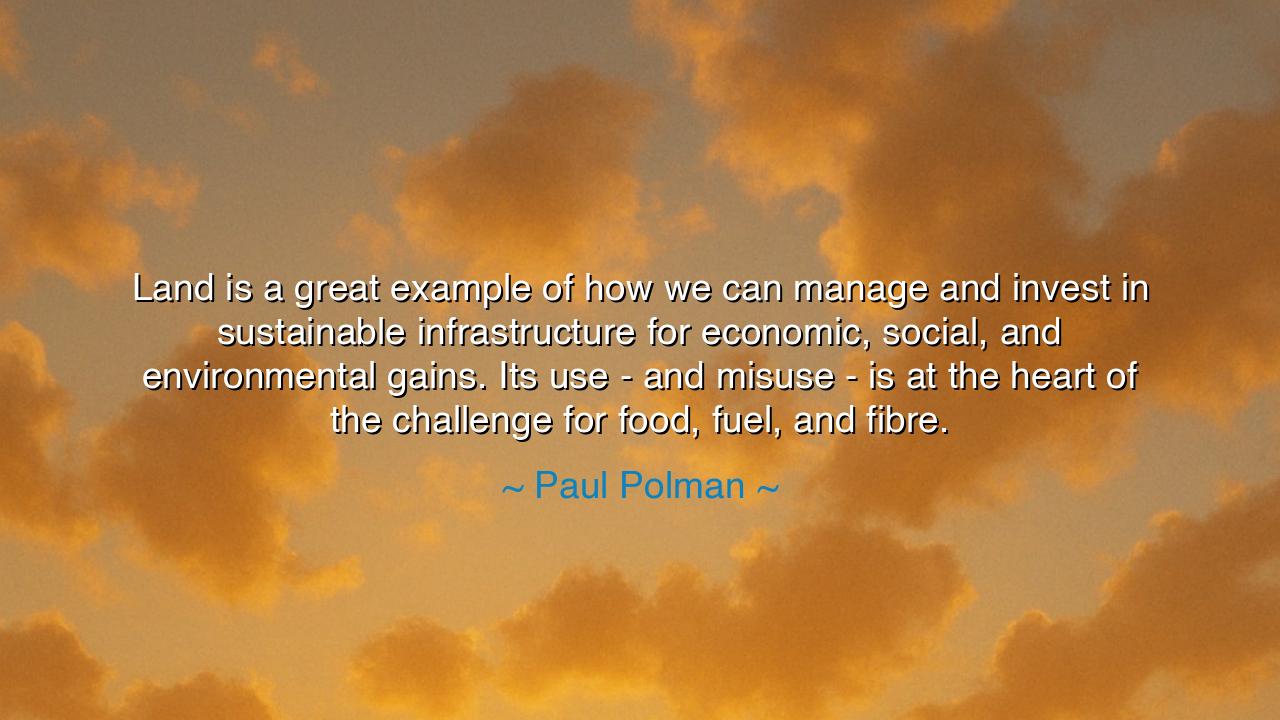
Land is a great example of how we can manage and invest in
Land is a great example of how we can manage and invest in sustainable infrastructure for economic, social, and environmental gains. Its use - and misuse - is at the heart of the challenge for food, fuel, and fibre.






In a voice of calm authority, forged in the fires of global stewardship, Paul Polman once declared, “Land is a great example of how we can manage and invest in sustainable infrastructure for economic, social, and environmental gains. Its use—and misuse—is at the heart of the challenge for food, fuel, and fibre.” These words are not the language of a mere economist, but of a modern philosopher—one who has seen that the ground beneath our feet is more than property; it is promise. In this brief yet profound reflection, Polman captures the essence of humanity’s covenant with the earth: that how we treat the land determines not only our prosperity, but our survival, our morality, and the inheritance we leave to those who follow.
The origin of this quote lies in Polman’s lifelong mission as a business leader and humanitarian, known for his work as CEO of Unilever and for championing the cause of sustainability in a world obsessed with short-term profit. In his stewardship of one of the world’s largest corporations, he sought to align commerce with conscience—to prove that economic growth need not devour the planet that sustains it. His mention of land as “sustainable infrastructure” reveals his deep understanding of balance: that soil, forests, and fields are not commodities to be consumed, but systems to be nurtured. They are living assets—capable of yielding food for the hungry, fuel for the industrious, and fibre for the clothed—if only we learn to honor their limits.
To the ancients, this truth would have seemed sacred. The Greeks spoke of Gaia, the living earth, mother of all things, whose abundance depended on human reverence. The Hebrews knew the Sabbath of the land, commanding that fields lie fallow every seventh year so the soil might rest and renew. Even the emperors of China, in the rituals of the Mandate of Heaven, understood that good governance meant harmony between ruler, people, and the earth itself. Polman’s words are the modern echo of these timeless principles: that civilization flourishes when it treats the land not as a resource to be mined, but as a partner to be respected.
Yet his warning is sharp and clear—misuse lies “at the heart of the challenge.” The burning of forests for profit, the over-plowing of fields, the poisoning of rivers, the sprawl of cities that consume the fertile plains—these are not merely environmental crimes, but moral ones. For every tree cut without renewal, every acre eroded by greed, diminishes not only the soil but the spirit of humanity. The hunger for food, fuel, and fibre—the necessities of modern civilization—has become the test of our wisdom. Shall we extract from the earth until it collapses beneath us, or shall we cultivate it as our ancestors once did, with care, gratitude, and foresight?
History is filled with lessons carved into dust. Consider the fall of Mesopotamia, the cradle of civilization. Once its rivers fed lush fields and thriving cities, but through over-irrigation and neglect, the soil turned to salt and the land to desert. The same land that had birthed writing and law became barren, and the people scattered. Their tragedy is our warning: that the misuse of land is the slow undoing of nations. And yet, there are also stories of renewal—like that of South Korea, which, after war left its hills stripped bare, embarked on decades of reforestation. Through patience and vision, they turned wasteland into woodland, erosion into abundance. In both stories, the land mirrors the soul of its stewards: decay where greed reigns, rebirth where reverence returns.
When Polman calls land a form of “sustainable infrastructure,” he lifts it beyond the realm of agriculture or economics and into the realm of ethics. For true sustainability demands not only efficient use, but moral restraint. To invest in the land is not merely to sow crops or build factories—it is to build systems that feed both body and spirit, to think in centuries rather than quarters. It is to recognize that soil and seed, rain and root, exist in a fragile harmony that can neither be rushed nor replicated by man’s machines. The wise do not seek to own the land, but to belong to it, as caretakers in an eternal cycle of giving and receiving.
Let this be the lesson his words pass down to us: that every decision about the earth is a decision about the future. To farm, to build, to buy, to consume—all these are acts of covenant, either in service of renewal or destruction. Each of us must learn to see the land not as dirt beneath our shoes, but as the living fabric that sustains us all. Walk upon it with reverence. Grow from it with gratitude. Give back to it with purpose.
For as Paul Polman teaches, the fate of the land is the fate of mankind. When we heal the soil, we heal the soul. When we build with wisdom, the earth repays us with abundance. But when we take without measure, the ground itself turns against us, and our plenty becomes poverty. So let us remember: stewardship is not the work of governments alone, but of every heart that dares to care. To live sustainably is not to limit life—it is to secure it, to plant hope where others sow destruction, and to ensure that the earth, our oldest home, remains fertile for generations yet unborn.






AAdministratorAdministrator
Welcome, honored guests. Please leave a comment, we will respond soon